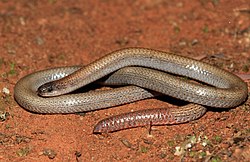| Aprasia | |
|---|---|
 | |
| Pink-tailed worm-lizard (Aprasia parapulchella) | |
| Scientific classification | |
| Domain: | Eukaryota |
| Kingdom: | Animalia |
| Phylum: | Chordata |
| Class: | Reptilia |
| Order: | Squamata |
| Infraorder: | Gekkota |
| Family: | Pygopodidae |
| Genus: | Aprasia Gray, 1839 |
 | |
Aprasia is a genus of lizards in the family Pygopodidae. The genus is endemic to Australia. [1] The species in the genus Aprasia are worm-like, burrowing lizards. At least four of the species are oviparous. [2]